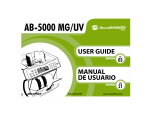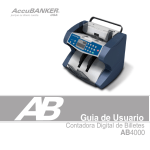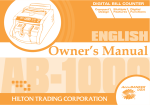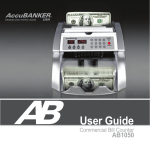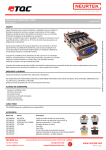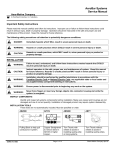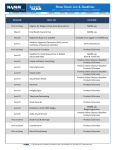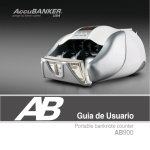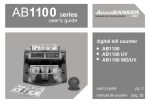Download AB5000PLUS Manual de Usuario
Transcript
AB5000 user’s guide because your money counts professional bill counter user’s guide manual de usuario pg. 3 pág. 27 WARNING Before turning the power on, please make sure that there are no objects obstructing the operation of the rollers and wheels. When operating this unit, please wait 5 minutes to allow the UV system reach its maximum detection capability AccuBANKER and its logo are registered trademarks or trademarks of Hilton Trading Corp. All Rights Reserved. 2 Thank you for purchasing this Professional Bill Counter. This User’s Guide compiles all the relevant instructions about the use and operation of the AB5000 PLUS. We recommend the new user to read this manual thoroughly, in order to get familiarized with the controls and operation of the unit. AB5000 PLUS PROFESSIONAL BILL COUNTER Getting Started 4-8 Table of Contents 9 Parts 10-11 Function Controls 12-14 Operation 15-18 UV Lamp Replacement 19-24 Error Message Display 25 Specifications 26 3 Getting Started AB5000 PLUS Features One of the most advanced bill counters available today, the AB5000 PLUS has been the talk of the industry since we first introduced it in the market. Equipped with a fully computerized mechanism, the AB5000 PLUS boosts variable counting speeds, digital task programming and dual means of counterfeit detection. It is also equipped with an acrylic molded cover to protect the user from the dust generated by the fast counting action. Stylish yet affordable, the AB5000 PLUS will make the most efficient and cost-effective device to help in counting, sorting and detecting counterfeit currency in any environment where moneys are used. ! ! ! ! ! ! ! ! ! ! ! 4 Convenient and easy to operate Fast and accurate counting Two starting modes (Auto/Manual) Three counting speeds (fast, normal and slow) Three changeable banknote condition levels Batch and free counting mode Addition counting mode Detection of paper bill size Counterfeit bill detection systems (magnetic and UV) Dust proof cover Error/trouble message display Features Getting Started Important Safety Instructions When using the bill counter, basic safety precautions should always be followed to reduce the risk of fire, electric shock or injury to persons, including the following: Warning Do not use this product in areas where it may be exposed to water or other liquids. Unplug this product from the wall outlet before cleaning. Do not use liquid or aerosol cleaners. Use a damp cloth for cleaning. To reduce the risk of electric shock, do not disassemble this product. Take it to qualified service personnel when service or repair work is required. Opening or removing covers may expose you to dangerous voltages or other risks. Incorrect re-assembly can cause electric shock when the appliance is subsequently used. Caution When unplugging the power plug, do not pull it by the cord but rather grip the plug to pull it out. Not following these instructions may result in electric shock, fire or damage to the unit. Do not use the unit if the power cord is damaged or if the plug socket contact is loose. Not following these instructions may result in electric shock, fire or other hazards. Do not place heavy objects over the cord and do not bend it excessively since it could get damaged. Not following these instructions may result in electric shock, fire or other hazards. When not using the unit for a long period of time, remove the power plug from the wall outlet. Only use the cable provided with the unit. The use of other cables may result in electric shock, fire or cause serious damage to the unit. Do not operate the unit in areas with high temperature or high humidity since it may prevent it from working correctly. Safety Instructions 5 Getting Started Other Safety Considerations 1 Read and understand all of the instructions. 2 Follow all warnings and instructions marked on the unit. 3 The slots and openings in the back or bottom of the case, are provided for ventilation, to protect the unit from overheating. These openings should never be blocked or covered by placing the product on the bed, sofa, rug, or similar surfaces. This product should never be placed near or over a radiator or heat register. This product should not be placed in a built-in installation unless proper ventilation is provided. 4 This product should be operated only from the type of power source indicated in the user guide. If you are not sure of the type of power supply in your location, consult your dealer or local power company. 5 This product is equipped with a three wire grounding type plug, a plug having a third (grounding) pin. This plug will only fit into a grounding type power outlet. This is a safety feature. If you are unable to insert the plug into the outlet, contact your electrician to replace the outlet. Do not try to defeat the safety purpose of the grounding type plug. 6 6 Never push objects of any kind into the unit through case slots, since they may touch dangerous voltage points or shortcut parts, resulting in a risk of fire or electric shock. Never spill liquids of any kind on the product. 7 Unplug this product from the wall outlet and refer servicing to qualified service personnel under the following conditions: ! ! ! ! ! ! When the power supply cord or plug is damaged or frayed. If liquid has been spilled into the unit. If the unit has been exposed to rain or water. If the unit does not operate normally by following the operating instructions. Adjust only those controls that are covered by the operating instructions. Improper adjustment of other controls may result in damage and will often require extensive work by a qualified technician to restore the product to normal operation. If the product has been dropped or the case has been damaged. If the product shows a noticeable change in performance. Safety Considerations Getting Started Box Contents When opening the box verify that all the items described below have been included. If any item is missing or damaged, contact the dealer where you purchased the unit. Bill Counter Unit Power Cable UV Lamp Only use the cable provided with the product. The use of other cables may result in electric shock, fire or cause serious damage to the unit. A box containing one (1) UV lamp replacement. (For directions about changing the UV lamp go to page 19) Box Contents Other Items Plastic cover, manual and Warranty Card 7 Getting Started Cleaning and Maintenance 1 Since the sensors in this unit are of the optical type, counting errors may be caused by paper particles, dust, dirt, stain, and other materials that get stuck or clutter the counting sensors. Also, it may be difficult to start the counting operation if the repeat and/or the auto-start sensor are cluttered with dust, paper particles, etc. 2 For effective operation of the unit, it is necessary to clean all the sensors shown in the picture on the right with a dry brush, periodically or as needed. 3 Due to the optical nature of the sensors in the unit, exposure to any direct light source should be avoided. 4 Since the machine uses a roller friction system, keep small objects such as pins, clips, necklaces or hair away from it to prevent them to get stuck in the mechanism. Clean the hopper and stacker with a dry brush or cloth, periodically or as needed. Keep the UV lamp clean by pulling and pushing the UV lamp cleaning-shaft. 8 Attention! Clean the unit only when the power is OFF. Do not use chemicals/abrasives to clean the unit. SENSORS Cleaning and Maintenance Contents Table of Contents Parts Function Controls Operation Turning the power ON Bill physical condition selector Counting mode Addition mode Halting and resuming mode Auto/MNL (manual) starting mode Thickness adjustment control Dust proof cover function Size of currency detection function Counterfeit bill detection - UV detection function - Magnetic detection function UV Lamp Replacement Error Message Display Specifications Table of Contents 10 12 15 15 15 15 16 16 16 16 16 17 17 17 18 19 25 26 9 Parts Parts Hopper Place the bills to be counted in this compartment. Counting Guides Aid to help position the bills correctly to be fed into the unit. UV Lamp Cleaning Shaft Built-in device that cleans the UV lamp. Thickness Adjustment Screw Used to make the counting operation smooth. The thickness adjustment is factory defaulted (for more information, refer to the Operation section, point 7 on page 16). Stacker The counted bills are stacked in this compartment. Power Switch Used to turn the power on or off. Power Inlet The supplied power cord should be connected to the power inlet first. The other end should be connected to the AC power outlet. Fluorescent Detection Sensitivity Adjustment Lever The fluorescent detection sensitivity can be adjusted by sliding this lever up or down (for more information refer to the Operation section, point 10 a on page 17). 10 Parts Parts Hopper UV Lamp Cleaning Shaft Counting Guides Thickness Adjustment Screw Power Inlet Power Switch Fluorescent Detection Sensitivity Adjustment Lever Parts Stacker 11 Function Function Controls Restart Button Used to initiate or reinitiate the counting operation, or to clear an error message shown on the display. Banknote Physical Condition Level Indicator Bar A fixed bar indicates the three available levels in the Bill Physical Condition Selector. Keypad This is a set of numerical keys (0-9) used to preset optional batch groups (up to 3 digits). Batch Function Button Every time this button is pressed, one of the preset quantities (10, 20, 25, 50, 100, “blank”) will be indicated rotationally on the Batch Number Display. Clear Button Used to remove the selected batch quantity on the Batch Number Display. MNL (manual) Button Used to select the auto starting or the MNL (manual) starting mode. Add (addition) Button Used to select or clear the Add function. Banknote Physical Condition Selector This button sets the bill counter sensors to three different levels, according to how dark or light is the ink on the bills to be counted. (For more information, refer to the Operation section, point 2 on page 15). 12 DD Key (Different Denomination) This button activates a function that detects any change in the size of the bills and selects the detection sensitivity. UV Detection Button (ultraviolet) This button activates the UV detection mechanism. This system detects counterfeit bills by means of UV fluorescence. MG Detection Button (magnetic) This button activates the magnetic detection mechanism. This system detects counterfeit bills by verifying magnetic features embedded in the notes. Function Controls Function Function Controls Counting Speed Button By pressing this key you can select the desired counting speed setting (fast, normal and slow). Counting Speed Indicator Indicates the current counting speed. Dust Proof Cover Function Button Activates or deactivates the dust proof cover. Batch Number Display This screen displays batch settings and other messages (up to three digits/characters). Counting Display This screen displays the bill counting results (up to four digits). Auto/MNL (manual) Indicator The indicator will be lit when the machine is set in the MNL (manual) start mode. Function Controls 13 DD Key (Different Denomination) Bill Physical Condition Selector Dust Proof Cover Function Button Bill Physical Condition Level Indicator Bar Counting Number Display Restart Button Auto/MNL Indicator Counting Speed Indicator Counting Speed Button Clear Button Batch Number Display Batch Function Button MNL (manual) Button Keypad Add Button UV detection Button (ultraviolet) MG detection Button (magnetic) 14 Function Controls Operation Operation Turning the Power ON To start operating the unit, turn it on by pressing the power switch located in the back. Bill Physical Condition Selector The Physical Condition level indicator should be lit in the middle position when the power is on. Change the level of this function by pressing the Bill Physical Condition Selector as follows (in case the error message “Ed” is displayed frequently). a) For bills that are stained or printed dark, set the level indicator in the darker position. b) For bills that are new or printed light, set the indicator in the lighter position. Counting Mode The unit can work in two modes, free counting mode and batch counting mode. Free Counting Mode In this mode, the machine counts all the bills in the hopper. This mode will be set when the “blank” option is selected on the Batch Number display, by pressing the Batch Function button. Batch Counting Mode In this mode, the machine counts the batch of bills assigned by the user. This counting mode may be set by entering a quantity (any number up to 999 except “blank”) on the Batch Number Display. Before beginning the counting function, use the Batch Function button or keypad to set the desired quantity or the “blank”, and then begin counting normally. Note: In the auto starting mode, the next counting operation will start automatically by only removing the counted bills from the stacker. In case the counting stops before the preset number has been reached, refill the hopper. The machine will continue counting automatically. Operation 15 Operation Addition Mode While working under the addition mode, the cumulative total is shown on the Counting Display. Press the ADD button to select this function (the Addition Indicator must be lit). To clear this function, press the Add button again. This will clear the Addition indicator. Halting and Resuming Mode To halt the machine during the counting operation, just press the Restart button. To resume the counting operation, press the Restart button again. Auto/MNL (manual) Starting Mode When the MNL (manual) button is pressed, the machine is under the MNL starting mode. In this mode, the machine will start counting, only, when the Restart key is pressed. When the MNL button is off, the machine is set to the AUTO starting mode. The machine will start the counting operation automatically when the hopper is filled with bills. Thickness Adjustment Control The Thickness Adjustment Control is factory defaulted. However it must be changed in the following two cases: 1) If the EC (chain) error occurs frequently, turn the Adjustment Control counterclockwise toward “-“ (thin). 2) If the feeding operation does not go smoothly due to new bills or thick paper sheets, turn the Adjustment Control clockwise toward “+” (thick). Dust Proof Cover Function Press the Dust Proof Cover Function button to select this function (the Dust Proof Cover indicator must be lit). When this function is selected, the Dust Proof Cover will close automatically before the counting operation begins. The cover automatically opens, in case the counting stops. To clear this function, press the Cover button until the indicator turns off. 16 Operation Operation Size of Currency Detection Function (Different Denomination Detection Function) Through this function, the size of the first counted bill will be memorized, and if a smaller one is detected, the machine will stop and the message “dd” will be shown on the Batch Number Display. This function can be enabled or disabled. The sensitivity of the DD function can be changed by pressing the DD button function to select the desired DD function code, as shown on the following table. Code d-0 d-2 d-3 d-4 Function DD function unavailable 2+1mm tolerance sensitivity 3+1mm tolerance sensitivity 4+1mm tolerance sensitivity Note: Every time you press the DD key, the function code will be shown on the Batch Display for one second and the DD Indicator will be lit. If the machine stops while operating under this function, verify the last two counted bills. Take away the smaller bill, press the RESTART button to clear the error message and recount all the bills. Counterfeit Bill Detection Function When operating in this mode, the machine will stop when a counterfeit bill is detected. A) UV Detection Function (ultraviolet) Counterfeit bills that do not generate fluorescence under the ultraviolet rays, can be detected when this function is selected. The machine will stop and the error message “CF1” will be shown on the Batch Number Display. The UV detection function may be selected by pressing the UV button (the UV Indicator will be lit). Operation 17 Operation Note: The UV Indicator can be lit in two colors. When in red, it means that the UV Function is normal. When the indicator is green, it means that the brightness of the UV lamp is low. In this case, you must select a proper fluorescent detection sensitivity to get the desired results. This can be achieved, by sliding the sensitivity lever located in the back of the unit to the highest position (the fluorescent detection sensitivity has four positions). If the machine stops because a counterfeit bill is detected, remove it, press the RESTART button to clear the error message and recount all the bills placed in the stacker. b) MG Detection Function (magnetic) In this mode, the machine will detect counterfeit bills using magnetic detection sensors. When a counterfeit bill is detected, the machine will stop and the error message “CF2” will be shown on the Batch Number Display. The MG detection function may be selected by pressing the MG button (the MG indicator will light up). To clear the MG function, press the MG button until the indicator turns off. Note: When the machine stops because a counterfeit bill is detected (the last one on the stacker,) take it away, press the RESTART key to clear the error message and recount all the bills placed in the stacker. Note: The ultraviolet and magnetic detection systems integrated in the AB5000 PLUS are valuable instruments to help the user verify the legitimacy of bills. However, the AB5000 PLUS, like all other counters with integrated detectors in the market, cannot guarantee the legitimacy of any bill analyzed by it due to the unpredictable techniques or advances that counterfeiters may introduce. 18 Operation Replacement UV Lamp Replacement The AB5000 PLUS includes a spare UV lamp that the user may exchange in case the original one burns out or breaks. Make sure the original lamp is burnt out or broken before replacing the part. Follow these instructions carefully: Note: before maintaining the machine, adjusting any part, or replacing any piece, make sure that the unit is turned OFF and unplugged from the power outlet. Manually, unscrew the cleaning rod located on the right side of the unit when seen from the back (turn counter clockwise to unscrew and vice versa) (see figure 1). Using a screwdriver, remove the screws located in the back of the unit (see figure 2). Figure 1 Figure 2 UV Lamp Replacement 19 Replacement Do the same with the screws located on both sides of the unit (see figure 3). Carefully remove the back plastic cover (see figure 4). Figure 3 20 Figure 4 UV Lamp Replacement Replacement Remove the two screws that hold the back metal plate (see figure 5). Once removed, carefully remove the metal plate and place it on the side. Do not disconnect the wirings from the metal plate. Just place the plate aside and attached to the wirings that may connect it to the unit (see figure 6). Figure 5 Figure 6 Unscrew both sides UV Lamp Replacement 21 Replacement Locate the UV lamp (see figure 7). Rotate it with your fingers until you can pull it from its housing (see figure 8). Once free, remove the cleaning device attached to it (see figure 9). Insert the new UV lamp into the cleaning device. Place the UV lamp -with the cleaning device attached- in the housing. Rotate it until it is secure in the housing. Figure 7 Figure 8 Figure 9 Make sure the cleaning device points in the right direction when inserting the new lamp 22 UV Lamp Replacement Replacement Grab the back plastic cover and place it in its original position. Screw it back to the unit. Unscrew the top plastic cover (see figure 10). Place your thumb on the thickness adjustment screw. Pull it back (see figure 11). Figure 10 Figure 11 Unscrew both sides UV Lamp Replacement 23 Replacement While pulling the thickness adjustment screw back, remove the plastic cover by grabbing it from the center (see figure 12). Once removed, insert the cleaning rod and visually, screw it back to the cleaning device. You may simplify the procedure by holding the cleaning device with a screwdriver (see figure 13). Once securely screwed, place the plastic cover where it should fit, pull the thickness adjustment screw back and refit the plastic cover. Once fitted in its original position, screw the top cover back. Figure 12 Figure 13 You may simplify the procedure by holding the cleaning device with a screwdriver 24 UV Lamp Replacement Error Messages Error Message Display ERROR MEANING CAUSE SOLUTION EJ Jam Bill is jammed in the machine Remove notes placed in the hopper (the machine will try remove the jammed bill. If not, you may have to remove it by hand) ED Double More than two bills are detected or a bill is detected that is too densely printed compared to a standard bill * Remove all the bills in the stacker * Press the “RESTART” button to clear the error code * Recount all the bills EC Chain More than two bills fed in chain EO Batch over stop The counting result is larger than the batch DD DD bill(s) Abnormal bills are mixed CF1 (UV) CF bill detection CF2 (MG) CF bill detection Error Messages Refer to Size of Currency Detection Function section (point 9, page 17) Refer to the Counterfeit Bill Detection Function section (point 10, page 17) 25 Specifications Specifications Ambient Temperature: Ambient Humidity: Feed System: Hopper Capacity: Stacker Capacity: Size of Countable Notes: Thickness of Countable Notes: Counting Number Display: Batch Preset Number Display: Power Source: Power Consumption: Dimensions: Weight: Denomination Detection Sensitivity: Counting Speed: - Fast - Normal - Slow 26 32°F - 104°F (0°C - 40°C) 30% - 80% Roller Friction System 200 sheets/new bills 100 sheets/old bills 200 sheets/new bills 100 sheets/old bills 50mm x 100mm - 100mm x 185mm 0.06mm x 0.12mm Four digits LED (large) Three digits LED (small) Single Phase 220 Volts + 10% RAM, 50 - 60 Hz Single Phase 110 Volts + 10% RAM, 50 - 60 Hz < 60 W 11” x 9” x 8” (275mm x 227mm x 195mm) 15.5 lb (7.0 kg) 2/3/4 + 1mm 1500 bills/min (approx.) 1000 bills/min (approx.) 700 bills/min (approx.) Specifications Gracias por comprar esta Contadora de Billetes Esta guía para el usuario contiene información pertinente al uso y operación de la AB5000 PLUS. Recomendamos que la lea en su totalidad para que se familiarice con los controles y operación de la unidad. CONTADORA DE BILLETES AB5000 PLUS Para Empezar 28-32 Índice 33 Partes 34-35 Controles 36-38 Operación 39-42 Reemplazo de la Lámpara UV 43-48 Solución a los Mensajes de Error 49 Especificaciones 50 27 Para Empezar Características de la AB5000 PLUS La AB5000 PLUS es una de las contadoras de billetes más avanzadas del mercado. Esto se debe a su sistema de procesamiento de funciones, que es completamente computarizado, y que le permite operar en diversas modalidades tales como conteo, adición, agrupación, etc. La identificación de billetes falsos se realiza mediante dos sistemas: ultravioleta y magnético. Además, posee una cubierta que se cierra para proteger al usuario del polvo generado por la acción de conteo. Usted quedará sorprendido con su versatilidad y fácil operación, indispensables en cualquier lugar donde se maneje dinero. ! ! ! ! ! ! ! ! ! ! ! Conveniente y fácil de operar Conteo rápido y preciso Dos modos de arranque (automático y manual) Tres velocidades de conteo Tres niveles de detección variables de acuerdo a la condición de los billetes Modo de conteo con o sin agrupamiento Modo de conteo con adición de totales Detección de billetes con denominaciones diferentes Sistema detector de billetes falsos Cubierta contra el polvo Pantalla que muestra mensajes de error 28 Características Para Empezar Instrucciones Importantes de Seguridad Al usar la contadora de billetes deberán tomarse estas precauciones básicas de seguridad para evitar riesgos de incendio, descarga eléctrica o daños a terceros. Advertencia No opere este producto en lugares donde pueda estar expuesto al agua o cualquier otro líquido. No opere este equipo en lugares húmedos. Antes de comenzar a limpiar la unidad, desenchúfela de la toma de alimentación eléctrica. No utilice limpiadores líquidos o en aerosol. Use únicamente un paño humedecido con agua. Para reducir el riesgo de descarga eléctrica, no desmantele la unidad. Cuando sea necesaria una reparación, llévela a un centro autorizado de servicio. Abrir o quitar la cubierta puede exponerlo a altos voltajes u otros riesgos. El ensamblaje incorrecto puede causar una descarga eléctrica cuando se vuelva a utilizar la unidad. Utilice únicamente el cable que viene con la unidad. El uso de otros cables puede resultar en descarga eléctrica, fuego o daño irreparable a la unidad. Precaución Cuando desenchufe la unidad de la toma de energía, no lo haga halando el enchufe por el cable, sino por la clavija. No seguir estas instrucciones puede resultar en riesgo de descarga eléctrica, fuego o daño a la unidad. No utilice esta unidad si el cable eléctrico está dañado o el contacto en la clavija esta suelto. No seguir estas instrucciones puede resultar en descarga eléctrica, fuego u otros peligros. No coloque objetos pesados sobre el cable y no lo doble excesivamente porque puede dañarlo. No seguir estas instrucciones puede resultar en descarga eléctrica, fuego u otros peligros. Cuando no use la unidad por un tiempo prolongado, desenchufe la clavija de la toma de alimentación. No operar esta unidad en áreas con altas temperaturas o excesiva humedad ya que puede resultar en un mal funcionamiento de la misma. Instrucciones de Seguridad 29 Para Empezar Otras Consideraciones de Seguridad 1 Lea y entienda todas las instrucciones. 2 Siga todas las precauciones e instrucciones señaladas en la unidad. 3 Las aberturas y rejillas en la parte posterior y base de la contadora, sirven para ventilar la unidad. Estas entradas no deben ser obstruidas o cubiertas colocando la contadora sobre una cama, sofá, alfombra u otra superficie similar. Este producto nunca deberá ser colocado cerca o encima de una estufa o sistema de calefacción. Este producto no deberá ser puesto en un compartimiento que no tenga la ventilación apropiada. 6 Nunca inserte objetos de ningún tipo por las rejillas o aberturas de la unidad ya que podrían tocar partes energizadas resultando en descarga eléctrica, fuego o daño a la unidad. Nunca derrame líquidos de ningun tipo sobre la unidad. 7 Desenchufe la unidad de la toma de alimentación y llévela a un centro autorizado de servicio en los siguientes casos: ! ! ! 4 5 30 Este producto deberá ser operado utilizando el voltaje correcto indicado en el manual de usuario. Si no está seguro del tipo de voltaje, consulte al distribuidor o a su compañía proveedora de electricidad. Este producto está equipado con un cable eléctrico de tres clavijas con conexión a tierra. Este enchufe encaja únicamente en una toma de corriente triple con conexión a tierra. Esta es una característica de seguridad. Si usted no puede insertar el enchufe correctamente, no lo fuerce, contacte a un electricista para reemplazar la toma de corriente por una adecuada al tipo de enchufe. ! ! ! Cuando el cable eléctrico esté dañado o gastado. Si algún líquido ha sido derramado sobre la unidad. Si el producto ha sido expuesto al agua u otros líquidos. Si el producto no funciona correctamente aún siguiendo las instrucciones (ajuste solamente los controles y partes mencionados en este manual. No trate de manipular otros aditamentos ya que podría dañar la unidad, lo que requerirá de técnicos calificados para restaurar el producto a su condición original). Si el producto ha sufrido una caida o golpe fuerte. Si el producto muestra algún cambio notorio en su funcionamiento. Otras Consideraciones Para Empezar Contenido de la Caja Compruebe que todas las partes descritas en esta página estén presentes al abrir la caja. Si falta algún artículo, o hay alguno que esté dañado, póngase en contacto con el concesionario donde adquirió la contadora de billetes. Cable eléctrico Lámpara de luz UV Utilice únicamente el cable que viene con la unidad. El uso de otro tipo de cables eléctricos puede resultar en descarga eléctrica, fuego o causar daño irreparable a la unidad. Una caja que contiene una (1) lámpara de luz UV de repuesto. (Para indicaciones de como reemplazar la lámpara UV vaya a la pág. 43) Contadora de billetes Contenido Otros artículos Cubierta de plástico, manual y tarjeta de garantía. 31 Para Empezar Limpieza y Mantenimiento 1 Si partículas de polvo, suciedad, etc, se adhieren a los sensores de conteo, pueden ocurrir errores en su funcionamiento, o puede que sea difícil comenzar la operación de conteo. 2 Para obtener mejores resultados es necesario limpiar con una brocha (periódicamente o cuando sea necesario) todos los sensores mostrados en la imagen de la derecha. 3 La máquina utiliza sensores ópticos, así que sugerimos mantener el equipo fuera del alcance directo de cualquier fuente directa de luz. 4 La unidad utiliza un sistema de rodillos de fricción, por esta razón, objetos tales como alfileres, presillas, cadenas y cabello deben ser mantenidos lejos de la misma para evitar que sean transportados hacia el interior. Mantenga limpios el alimentador y la bandeja receptora, usando para ésto una brocha. 5 Es importante limpiar la lámpara UV usando la varilla que está al costado de la unidad. (Ésto se logra halándola hacia afuera y empujándola nuevamente hacia el interior de la unidad). 32 Atención! Desconecte la unidad antes de limpiarla. No utilice productos químicos ni abrasivos para limpiar la unidad. SENSORES Limpieza y Mantenimiento Índice Índice Partes Controles Operación Encendido Botón para regular detección de acuerdo al estado físico de los billetes Selección del modo de conteo Función de conteo mediante acumulación de totales Detención y continuación del conteo Modos de conteo automático y manual Tornillo de ajuste del grosor de alimentación de los billetes Activación de la cubierta a prueba de polvo Detección de billetes por tamaño (diferente denominación) Detección de billetes falsos - Detección ultravioleta (UV) - Detección magnética (MG) Reemplazo de la Lámpara UV Solución a los Mensajes de Error Especificaciones Índice 34 36 39 39 39 39 40 40 40 40 40 41 41 41 42 43 49 50 33 Partes Partes Alimentador Los billetes a contar deben ser colocados aquí. Guías de Conteo Se utilizan para alinear los billetes que entrarán en el sistema alimentador. Varilla Limpiadora de la Lámpara Ultravioleta Se utiliza para limpiar la lámpara ultravioleta que se encuentra en el interior de la unidad. Tornillo de Ajuste del Grosor de Alimentación de los Billetes Se usa para ajustar el sistema de acuerdo con el grosor de los billetes a contar. Este control ha sido preajustado por el fabricante(para más información refiérase al punto 7 en la sección “Operación”, página 40). Bandeja Receptora Los billetes contados son acumulados en la bandeja receptora. Interruptor General Pone en funcionamiento la unidad. Entrada para Alimentación Eléctrica (enchufe) El cable de alimentación que acompaña a la unidad se conecta en esta entrada. Selector de Sensibilidad para la función de Detección Ultravioleta La sensibilidad de detección ultravioleta puede variarse mediante este selector (para más información refiérase a “Operación”, punto 10 a, página 41). 34 Partes Partes Alimentador Guías de conteo Varilla limpiadora de la lámpara UV Tornillo de ajuste del grosor de alimentación de los billetes Entrada para alimentación eléctrica (enchufe) Interruptor general Bandeja receptora Partes Selector de sensibilidad para la función de detección ultravioleta 35 Controles Controles Botón RESTART Se usa para iniciar la operación de conteo o borrar un mensaje de error que aparezca en la pantalla. Teclado Numérico Este es un conjunto de teclas numéricas (del 0 al 9) que se utilizan para preseleccionar la cantidad de billetes a agrupar (hasta 3 dígitos). Botón de Cancelación Elimina en la pantalla el número preseleccionado de agrupamiento. Botón MNL(manual) Selecciona el modo de arranque: automático o manual. Botón de Sumar Activa o desactiva la función de sumar. Botón para Regular Detección de Acuerdo al Estado Físico de los Billetes Se utiliza para regular la detección de billetes de acuerdo con el estado de la impresión de los mismos (para más detalles refiérase a “Operación” punto 2). 36 Controles Indicador de Selección del Estado Físico de los Billetes Indica el nivel seleccionado con el botón regulador de detección de acuerdo al estado físico de los billetes. Botón de Agrupación Cada vez que esta tecla es presionada una de las opciones de agrupamiento de billetes a contar (10, 20, 25, 50, 100, “en blanco”) aparecerá en la pantalla. Botón DD (diferente denominación) Configura la unidad para detectar denominaciones (por tamaño) y seleccionar la sensibilidad de detección. Botón de Detección Ultravioleta (UV) Permite que la unidad detecte billetes falsos mediante el uso de luz ultravioleta. Botón de Detección Magnética (MG) Activa la unidad para reconocer los billetes falsos mediante el sistema de detección magnética. Controles Controles Botón Regulador de Velocidad Permite escoger la velocidad de conteo deseada (rápida, normal o lenta). Indicador de Velocidad Indica la velocidad seleccionada para el conteo de billetes. Botón Activador de la Cubierta a Prueba de Polvo Cierra y abre la cubierta protectora a prueba de polvo. Pantalla de Agrupamiento Muestra el número de agrupamiento seleccionado y mensajes de error (hasta 3 dígitos). Pantalla de Cantidades Contadas Muestra los resultados del conteo de billetes (hasta 4 dígitos). Indicador Auto / MNL(manual) Éste se iluminará cuando la unidad esté funcionando en el modo de arranque MNL(manual). Controles 37 Botón DD (diferente denominación) Botón para regular detección de acuerdo al estado físico de los billetes Indicador de selección del estado físico de los billetes Pantalla de cantidades contadas Botón activador de la cubierta a prueba de polvo Indicador Auto/MNL Botón RESTART Indicador de velocidad Botón regulador de velocidad Pantalla de agrupamiento Botón de cancelación Botón de agrupación Botón MNL (manual) Botón de sumar Botón de detección UV (ultravioleta) Botón de detección MG (cabezal magnético) 38 Controles Teclado numérico Operación Operación Encendido El interruptor general de encendido de la unidad se encuentra en la parte posterior de la misma. Botón para Regular Detección de Acuerdo al Estado Físico de los Billetes Cuando la unidad se pone en funcionamiento, el indicador de detección de condición de billetes debe estar iluminado en la posición intermedia. En caso de que el mensaje de error “Ed” aparezca frecuentemente en la pantalla, cambie el nivel del mismo oprimiendo el botón para regular la detección de acuerdo al estado de los billetes usando las siguientes reglas: a) Para billetes manchados -con impresión oscura-, coloque el indicador luminoso en la posición más oscura de la barra. b) Para billetes que estén nuevos -con impresión clara-, coloque el indicador luminoso en la posición más clara de la barra. Selección del Modo de Conteo La unidad puede trabajar en dos modalidades: libre y por agrupamiento. Modo de conteo libre: En este modo la unidad cuenta todos los billetes colocados en el alimentador sin detenerse. Para activar esta modalidad, seleccione “en blanco” (pantalla en blanco) en la pantalla del número de agrupamiento presionando el botón correspondiente. Modo de conteo por agrupamiento: En este modo la unidad cuenta la cantidad de billetes que usted haya preseleccionado. Escoja cualquier cantidad hasta 999 (excepto “en blanco”). Antes de comenzar el conteo use la tecla de agrupamiento o el teclado para seleccionar el número deseado y entonces comience el conteo normalmente. Nota: Cuando la unidad esté en el modo de conteo automático, el próximo conteo comenzará automáticamente con sólo quitar los billetes ya contados de la bandeja receptora. Operación 39 Operación Función de Conteo Mediante el Acumulador de Totales Bajo esta función, el total acumulado se muestra en la pantalla del contador de billetes. Oprima la tecla “Add” para activar esta función lo cual iluminará el indicador que está al lado del selector de suma de billetes. Para desactivar esta función, presione nuevamente la tecla “Add”. Esta acción apagará el indicador. Detención y Continuación del Conteo Para detener la unidad durante la operación de conteo, solamente oprima la tecla “RESTART”. Para continuar el conteo oprima nuevamente la tecla “RESTART”. Modos de Conteo Automático y Manual Cuando se ilumina el indicador MNL(manual), la unidad está funcionando en el modo manual. En este caso, comenzará a contar solamente cuando se presione la tecla “RESTART”. Cuando el indicador MNL(manual) esté apagado, la unidad estará en el modo de arranque automático. En este modo, la unidad contará automáticamente los billetes que sean colocados en el alimentador. Tornillo de Ajuste del Grosor de Alimentación de Billetes El tornillo de ajuste de alimentación de billetes ha sido preajustado por el fabricante, pero debe recalibrarse en los siguientes dos casos: 1) El mensaje de error “EC” (billetes encadenados) aparece frecuentemente. Gire el tornillo en contra de las manecillas del reloj hacia “-“ (fino). 2) La operación de alimentación no funciona con facilidad debido a que los billetes son nuevos y/o que el papel es muy grueso, gire el tornillo en el sentido de las manecillas del reloj hacia “+” (grueso). Activación de la Cubierta a Prueba de Polvo Presione el botón “COVER”. El indicador de se iluminará. Bajo esta función, la cubierta a prueba de polvo se cerrará automáticamente antes de comenzar el conteo y se abrirá en caso de que éste se detenga. Para desactivar esta función, oprima nuevamente la tecla “COVER”. 40 Operación Operación Detección de Billetes por Tamaño (diferente denominación) Mediante esta función, el tamaño del primer billete contado será memorizado y si uno más pequeño es detectado, la unidad se detendrá y el mensaje “dd” aparecerá en la pantalla de cantidad de agrupamiento. Esta función puede ser seleccionada o no, y la sensibilidad puede cambiarse oprimiendo la tecla “DD” para escoger el código de función mostrado en la siguiente tabla: Código d-0 d-2 d-3 d-4 Función Función DD no disponible 2+1mm tolerancia de sensibilidad 3+1mm tolerancia de sensibilidad 4+1mm tolerancia de sensibilidad Nota: Cada vez que usted oprima la tecla “DD” el código de funcionamiento se mostrará por espacio de un segundo en la pantalla de agrupamiento y el indicador de “DD” se iluminará. Cuando la unidad se detenga, operando bajo el modo de conteo rápido, verifique los últimos dos billetes contados, saque el más pequeño, presione la tecla “RESTART” para borrar el mensaje de error y vuelva a contar los billetes. Detección de Billetes Falsos La unidad se detendrá cuando detecte un billete falso y esté operando bajo cualquiera de estas funciones: a) Detección Ultravioleta (UV) Un billete falso que no genere fluorescencia bajo los rayos ultravioletas puede ser detectado cuando se activa esta función. La unidad se detendrá y el mensaje de error “CF1' aparecerá en la pantalla de número de agrupamiento. La función de detección ultravioleta es activada al oprimir el botón “UV” (el indicador correspondiente debe iluminarse). Operación 41 Operación Nota: El indicador UV puede iluminarse en dos colores; cuando se ilumina en rojo significa que la función “UV” es normal. Cuando el indicador se ilumina en verde significa que la luz generada por la lámpara ultravioleta es débil. En este caso, debe seleccionarse una sensibilidad de detección fluorescente apropiada para obtener el resultado deseado. Ésto se logra ajustando el controlador de sensibilidad del detector ultravioleta en una posición más alta. La sensibilidad de detección fluorescente tiene cuatro niveles. En caso que se detecte un billete falso y la unidad se detenga, extraiga el billete falso, oprima la tecla “RESTART” para borrar el mensaje de error y vuelva a contar todos los billetes que estén en la bandeja receptora. b) Detección Magnética (MG) Cuando esta función esté activada, la unidad detectará billetes falsos mediante detección magnética. Cuando un billete falso sea detectado, la unidad se detendrá y el mensaje de error “CF2” aparecerá en la pantalla de número de agrupamiento. La detección MG se selecciona oprimiendo el botón “MG” (el indicador debe iluminarse). Para desactivar la función MG, apriete nuevamente este botón(el indicador se desactivará). Nota: Cuando la unidad se detenga por causa de un billete falso(el último en la bandeja receptora), extráigalo, apriete la tecla “RESTART” para borrar el mensaje de error, y cuente otra vez todos los billetes que estén en la bandeja receptora. Nota: Los sistemas ultravioleta y magnético integrados en la unidad son instrumentos valiosos para detectar billetes falsos. Sin embargo, al igual que cualquier otra contadora con detectores incorporados, la AB5000 PLUS no garantiza la legitimidad de los billetes debido a los avances impredecibles en falsificación de dinero. 42 Operación Remplazo Reemplazo de la Lámpara UV La contadora AB5000 PLUS trae una lámpara UV de repuesto que el usuario puede reemplazar en caso que la original se queme o rompa. Verifique que la lámpara original esté quemada o rota antes de cambiarla. Siga las siguientes instrucciones cuidadosamente: Nota: antes de dar cualquier tipo de mantenimiento, ajustar alguna pieza o reemplazar algún componente, verifique que la máquina esté apagada y desconectada de la toma de alimentación. Desatornille manualmente la varilla de limpieza ubicada en el lado derecho de la unidad vista desde atrás (en el sentido opuesto a las manecillas del reloj para desajustar y viceversa) (ver figura 1). Retire los tornillos ubicados en la parte posterior de la unidad (ver figura 2). Figura 1 Figura 2 Remplazo de la Lámpara UV 43 Remplazo Haga lo mismo con los tornillos ubicados a ambos lados de la unidad (ver figura 3). Cuidadosamente, retire la cubierta plástica posterior (ver figura 4). Figura 3 44 Figura 4 Remplazo de la Lámpara UV Remplazo Retire los dos tornillos que sujetan la placa metálica posterior (ver figura 5). Una vez retirados, retire la placa metálica y colóquela a un lado. No desconecte los cables. Solamente coloque la placa a un costado, manteniéndola conectada a los cables que la unen con la unidad (ver figura 6). Figura 5 Figura 6 Retirar los tornillos de ambos lados Remplazo de la Lámpara UV 45 Remplazo Ubique la lámpara UV (ver figura 7). Gírela con los dedos hasta que quede libre(ver figura 8). Una vez libre, retire el dispositivo de limpieza (ver figura 9). Inserte la nueva lámpara UV dentro del dispositivo de limpieza. Coloque la lámpara UV con el dispositivo de limpieza adjunto en la cavidad correspondiente. Figura 7 Figura 8 Figura 9 Verifique que el dispositivo de limpieza apunte en la dirección correcta a la hora insertar la nueva lámpara 46 Remplazo de la Lámpara UV Remplazo Coloque la cubierta plástica posterior en su posición original y atorníllela a la unidad. Desatornille la tapa plástica superior (ver figura 10). Coloque el pulgar sobre el tornillo de ajuste de alimentación. Hálelo hacia atrás (ver figura 11). Figura 10 Figura 11 Retire ambos tornillos Remplazo de la Lámpara UV 47 Remplazo Mientras lo hala, sujete la cubierta plástica por la parte central y retírela (ver figura 12). Inserte la varilla de limpieza y visualmente, atorníllela al dispositivo de limpieza. Puede simplificar el procedimiento sujetando un extremo de la pieza con un desatornillador (ver figura 13). Una vez ajustada la varilla de limpieza, coloque la tapa plástica superior donde corresponde, hale el tornillo de ajuste de alimentación y ajuste la tapa en su posición original. Atorníllela a la unidad. Figura 12 Figura 13 Puede simplificar el procedimiento sujetando un extremo del dispositivo de limpieza con un desatornillador 48 Remplazo de la Lámpara UV Mensajes Solución a los Mensajes de Error SOLUCION ERROR SIGNIFICADO EJ Atascado Billete atascado en la unidad. Extraiga los billetes que están en el alimentador. La unidad tratará de expulsar el billete atascado (si esto no ocurre, deberá retirarlo manualmente). ED Arrastre de Billetes (doble) Más de dos billetes son detectados o uno está impreso más oscuro en comparación con otro regular. *Extraiga todos los billetes que están en la bandeja receptora. *Oprima la tecla “RESTART” para borrar el mensaje de error. *Vuelva a contar todos los billetes. EC Billete encadenado Más de un billete ha entrado en el sistema. EO Exceso en la agrupación El resultado del conteo es mayor que la agrupación. DD Billete(s) DD Billetes distintos mezclados. CF1 (UV) Detección de Billete Falso (UV) CF2 (MG) Detección de Billete Falso (MG) CAUSA Mensajes de Error Refiérase a la sección “Detección de billetes por tamaño” (punto 9, página 41) Refiérase a la sección “Detección de billetes falsos” (punto 10, página 41) 49 Especificaciones Especificaciones Temperatura Ambiente: Humedad Ambiental: Sistema Alimentador: Capacidad del Alimentador: Capacidad de la Bandeja Receptora: Tamaño de Billete: Grosor de Billete: Pantalla de Conteo de Billetes: Pantalla de Conteo de Agrupaciones: Fuente de Alimentación: Consumo de Energía: Dimensiones: Peso: Sensibilidad de Detección de Denominación: Velocidad de Conteo: - Rápida - Normal - Lenta 50 32°F - 104°F (0°C - 40°C) 30% - 80% Sistema de rodillos de fricción 200 hojas / billetes nuevos 100 hojas / billetes usados 200 hojas / billetes nuevos 100 hojas / billetes usados 50mm x 100mm - 100mm x 185mm 0.06mm x 0.12mm Indicador de cuatro dígitos (grande) Indicador de tres dígitos LED (pequeño) Monofásica 220 Voltios + 10% RAM, 50 - 60 Hz Monofásica 110 Voltios + 10% RAM, 50 - 60 Hz < 60 W 11” x 9” x 8” (275mm x 227mm x 195mm) 15.5 lb. (7.0 kg) 2/3/4 + 1mm 1500 billetes / min (aprox.) 1000 billetes / min (aprox.) 700 billetes / min (aprox.) Especificaciones PRECAUCIÓN Verifique que no haya ningún objeto obstruyendo el libre movimiento de los rodillos y ruedas receptoras de billetes antes de encender la máquina. Encienda y espere 5 minutos antes de operarla, para que el sistema ultravioleta alcance su máxima potencia AccuBANKER y su logo son marcas registradas de Hilton Trading Corp. Todos los derechos reservados. 51




















































